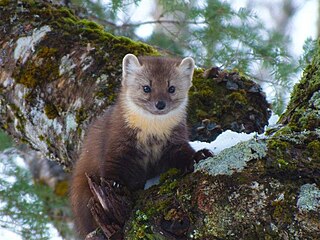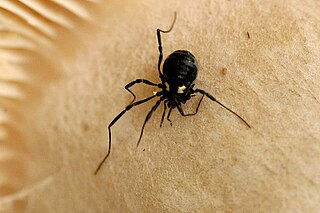
The Mustelidae are a diverse family of carnivoran mammals, including weasels, badgers, otters, polecats, martens, grisons, and wolverines. Otherwise known as mustelids, they form the largest family in the suborder Caniformia of the order Carnivora with about 66 to 70 species in nine subfamilies.

Dr. Martens also known as Doc Martens, Docs, or DMs, is a footwear and clothing brand, headquartered in Wollaston, Northamptonshire. Although famous for its footwear, the company also makes a range of accessories including clothing and bags. The footwear is distinguished by its air-cushioned sole, upper shape, welted construction, and yellow stitching. The Dr. Martens' design studio is in Camden Town, London, England. The company manufactures in the UK, China, Vietnam, Laos, and Thailand. The company is listed on the London Stock Exchange and is a constituent of the FTSE 250 Index.

The sable is a species of marten, a small omnivorous mammal primarily inhabiting the forest environments of Russia, from the Ural Mountains throughout Siberia, and northern Mongolia. Its habitat also borders eastern Kazakhstan, China, North Korea and Hokkaido, Japan.

A marten is a weasel-like mammal in the genus Martes within the subfamily Guloninae, in the family Mustelidae. They have bushy tails and large paws with partially retractile claws. The fur varies from yellowish to dark brown, depending on the species; it is valued by animal trappers for the fur trade. Martens are slender, agile animals, which are adapted to living in the taiga, and inhabit coniferous and northern deciduous forests across the Northern Hemisphere.

The European pine marten, also known as the pine marten, is a mustelid native to and widespread in most of Europe, Asia Minor, the Caucasus and parts of Iran, Iraq and Syria. It is listed as Least Concern on the IUCN Red List. It is less commonly also known as baum marten or sweet marten.

The American marten, also known as the American pine marten, is a species of North American mammal, a member of the family Mustelidae. The species is sometimes referred to as simply the pine marten. The name "pine marten" is derived from the common name of the distinct Eurasian species, Martes martes. Martes americana is found throughout Canada, Alaska, and parts of the northern United States. It is a long, slender-bodied weasel, with fur ranging from yellowish to brown to near black. It may be confused with the fisher, but the marten is lighter in color and smaller. Identification of the marten is further eased by a characteristic bib that is a distinctly different color than the body. Sexual dimorphism is pronounced, with males being much larger.

The beech marten, also known as the stone marten, house marten or white breasted marten, is a species of marten native to much of Europe and Central Asia, though it has established a feral population in North America. It is listed as Least Concern on the IUCN Red List on account of its wide distribution, its large population, and its presence in a number of protected areas. It is superficially similar to the European pine marten, but differs from it by its smaller size and habitat preferences. While the pine marten is a forest specialist, the beech marten is a more generalist and adaptable species, occurring in a number of open and forest habitats.

A grison is any mustelid in the genus Galictis. Native to Central and South America, the genus contains two extant species: the greater grison, which is found widely in South America, through Central America to southern Mexico; and the lesser grison, which is restricted to the southern half of South America.

The Japanese marten is a marten species endemic to Japan.

The Nilgiri marten is the only marten species native to southern India. It lives in the hills of the Nilgiris and parts of the Western Ghats. With only around a thousand members left it is listed as Vulnerable on the IUCN Red List.

Guloninae is a subfamily of the mammal family Mustelidae distributed across Eurasia and the Americas. It includes martens and the fisher, tayra and wolverine. These genera were formerly included within a paraphyletic definition of the mustelid subfamily Mustelinae.

The yellow-throated marten is a marten species native to the Himalayas, Southeast and East Asia. Its coat is bright yellow-golden, and its head and back are distinctly darker, blending together black, white, golden-yellow and brown. It is the second-largest marten in the Old World, after the Nilgiri marten, with its tail making up more than half its body length.
Typhlocypris cavicola is a species of ostracod crustacean in the family Candonidae. It is endemic to Slovenia, where it is only known from Krka Cave.
Typhlocypris trigonella is a species of ostracod crustacean in the family Candonidae. It is endemic to Slovenia, where it is known only from Postojna Cave.

The Sclerosomatidae are a family of harvestmen with about 1,300 known species. One former subfamily has been recently removed to form a new family, Globipedidae.

The Nemastomatidae are a family of harvestmen with about 170 described species in 16 recent genera. Several fossil species and genera are known.

Athleta is a genus of sea snails, marine gastropod mollusks in the family Volutidae.

Candonidae is a family of ostracods, containing around 25% of all known species of freshwater ostracods. Around 75% of genera in the family are endemic to a single zoogeographic region. It contains more than 500 species, of which more than 300 are endemic to the Palearctic realm.
Tambacarnifex is an extinct genus of varanodontine synapsids known from the Early Permian Tambach Formation of Free State of Thuringia, central Germany. It was first named by David S. Berman, Amy C. Henrici, Stuart S. Sumida, Thomas Martens and Valerie Pelletier in 2013 and the type species is Tambacarnifex unguifalcatus.

The Pacific marten is a species of North American mammal, a member of the family Mustelidae. It is found throughout western North America.















